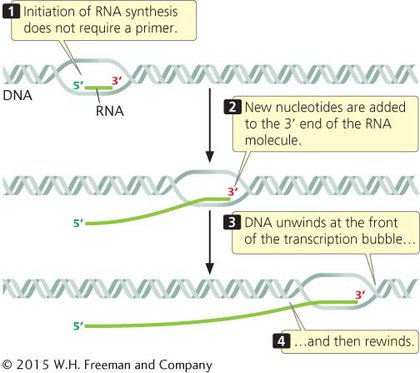The Substrate for Transcription
RNA is synthesized from ribonucleoside triphosphates (rNTPs; Figure 10.7). In synthesis, nucleotides are added one at a time to the 3′-OH group of the growing RNA molecule. Two phosphate groups are cleaved from the incoming ribonucleoside triphosphate; the remaining phosphate group participates in a phosphodiester bond that connects the nucleotide to the growing RNA molecule. The overall chemical reaction for the addition of each nucleotide is
RNAn + rNTP → RNAn+1 + PPi
in which PPi represents pyrophosphate. Nucleotides are always added to the 3′ end of the RNA molecule, and the direction of transcription is therefore 5′→3′ (Figure 10.8), the same as the direction of DNA synthesis in replication. Thus, the newly synthesized RNA is complementary and antiparallel to the template strand. Unlike DNA synthesis, RNA synthesis does not require a primer.


CONCEPTS
RNA is synthesized from ribonucleoside triphosphates. Transcription is 5′ → 3′: each new nucleotide is joined to the 3′-OH group of the last nucleotide added to the growing RNA molecule.